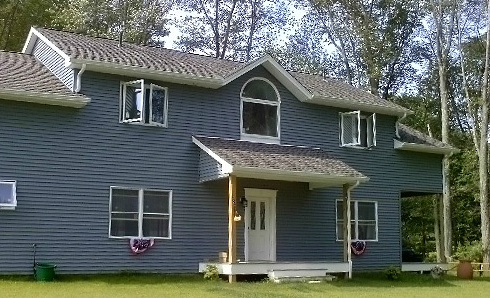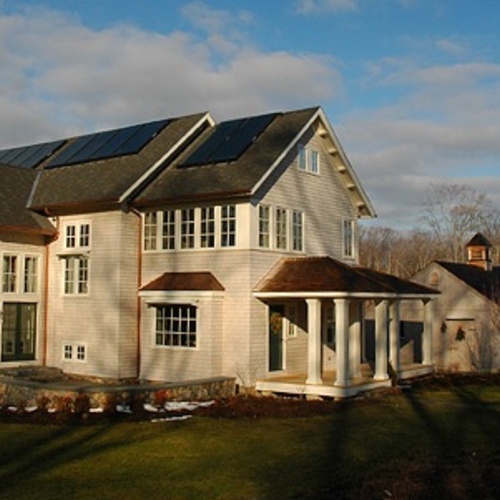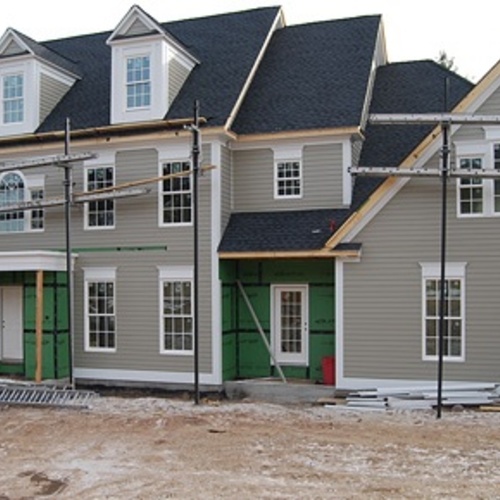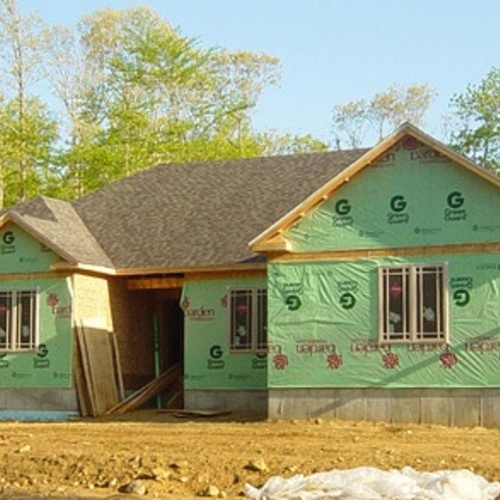Image Credit: Connecticut Energy Efficiency Fund
Image Credit: Connecticut Energy Efficiency Fund This 2,800-sq.-ft. two-bedroom in Voluntown won in the “most affordable” category, earning homeowners John and Delaine Simonds a Challenge prize of $5,000. Located in Ashford, this 1,728-sq.-ft. three-bedroom won $5,000 in the Challenge category ranking HERS Index ratings when the entries operate without their renewable-energy systems. This house includes a 4.2 kW photovoltaic system and a ground-source heat pump. Bernard Zahren’s 5,327-sq.-ft. five-bedroom in Avon, which won two$5,000 prizes in the Challenge, one for the lowest overall HERS Index score (minus 9) and one for the lowest projected annual net operating costs. The project has a ground-source heat pump and two renewable energy systems (a solar hot water system and a wind turbine).
Four of the 11 entries in the 2010-2011 Connecticut Zero Energy Challenge found their way to the winners’ circle, each taking a different path to exemplary energy efficiency performance.
The winner of the $10,000 grand prize, for example, is Sam and Teri Norman’s 2,492-sq.-ft. four-bedroom single-family in Coventry, which posted the lowest combined contest score (including the building’s HERS Index rating), and features a ground-source heat pump and a PV system, and cost $101 per sq. ft. to construct. With an R-10 slab, R-40 ceiling, and R-33 walls sealed using Huber’s AdvanTech Zip System sheathing and tape, the house relies mostly on its passive-solar design for heat. The Normans say they consider the heat pump to be a backup heating system. There’s also a wood stove in a central part of the home, which features an open floor plan.
A 2,800-sq.-ft. two-bedroom in Voluntown, meanwhile, won in the “most affordable” category (measured by cost per sq. ft.), earning homeowners John and Delaine Simonds a Challenge prize of $5,000. This house also relies heavily on its passive solar design for heat, as well as on a ground-source heat pump for heating and cooling. The home has a leased photovoltaic system.
A small house wins once and a big house wins twice
The smallest single-family of the 11 entries, a 1,728-sq.-ft. three-bedroom in Ashford, won $5,000 in the Challenge category ranking HERS Index ratings when the entries operate without their renewable-energy systems. This house, whose exterior walls and roof were constructed of structural insulated panels, includes a 4.2-kW photovoltaic system and a ground-source heat pump.
That takes care of three prize categories. But there actually are five prizes in this edition of the Challenge, and the fourth house to win – Bernard Zahren’s 5,327-sq.-ft. five-bedroom in Avon – won the remaining two prizes: $5,000 for the lowest overall HERS Index score (minus 9) and another $5,000 for the lowest projected annual net operating costs. The project has a ground-source heat pump and two renewable energy systems: a solar hot water system and a wind turbine that sits on a 100-ft. tower and can generate about 21,497 kWh of power annually. The house also is designed to accommodate a photovoltaic array on its highest roof.
GBA posted a brief on Zahren’s project as it got underway in 2009 and noted its insulation strategy (R-20 foundation and flooring, R-40 exterior walls, and an R-60 roof) and the fact that it is a renovation of what was a very leaky three-story 3,300-sq.-ft. house.
Sponsors and rules
The contest is sponsored by the Connecticut Energy Efficiency Fund energy conservation initiative and five utilities: Connecticut Light & Power, the United Illuminating Company, Connecticut Natural Gas, Southern Connecticut Gas, and Yankeegas.
Unlike the 2009-2010 edition of the Challenge, there was no size limit on the 2010-2011 entries. The group of 11 projects includes dwellings as small as the 1,576-sq.-ft. units in a set of three duplexes in Hartford and the 1,728-sq.-ft. three-bedroom in Ashford. The largest is a 6,500-sq.-ft. five-bedroom in Avon.
All entries had to be a customer of one of the participating utilities and had to be analyzed and scored by a certified HERS rater before construction began and after construction was completed. Owner-occupied entries eligible for rebates on photovoltaic installations through the Connecticut Energy Efficiency Fund were required to install a PV system. Builders of non-owner-occupied homes, which are not eligible for CEEF rebates, had to design their projects to be PV-ready and, if they didn’t install a system, were given a “simulated” PV system credit of 1 kW per 1,000 sq. ft. of living space.
Weekly Newsletter
Get building science and energy efficiency advice, plus special offers, in your inbox.
















3 Comments
Ground Source Heat Pumps?
I'd just like to mention that even though all these homes have ground source heat pumps, GSHP is NOT considered best practice in a well-insulated low energy home. Minisplits can be employed for a fraction of the first cost without any performance penalty.
I'm really impressed with the cost per square foot these homes acheived. However, they aren't eye candy.
Don't ever let first cost and energy efficiency trump " firmitas, utilitas, venustas."
the lowest overall HERS Index score and project operating costs
Additional information on the Zahren project, winning two catagories -the lowest overall HERS Index score (minus 9) and the lowest projected annual net operating costs, can be found at the websites of the architect:
Wadsworth Kamm Architects of Glastonbury, Connecticut
http://www.WadsworthKamm.com
http://www.Facebook.comWadsworth-Kamm-Architects
And on the website of the General contractor:
Gable Construction of Portland Connecticut
http://www.GableConstruction.com
Whats included in the SF costs?
Question about the square foot cost, what is included in that?
Does it include design fees?
Does it include the HERS rater’s fees?
Does include permit fees?
Does it include excavation costs?
Does it include the septic system or sewer connection?
Does it include the cost to drill the well or connect to the city water supply?
Does it include appliances?
Does it include plumbing fixtures?
Light fixtures?
Tile?
Paint?
Finish landscaping?
Who built the house? A contractor for a client, a contractor for himself. If the contractor built it for himself does that $101 per SF include all of his management time on the job, off the job?
I used to work with an Architect who would brag to me about how cheap he would built his own projects, but when I asked questions it turned out he never factored in his own time to design, permit, manage, build his own cabinets, finish them, paint the place etc..
Also what about location? I also live in CT, but I can tell you that costs in Greenwich Ct. (50 miles from mid-town Manhattan) are much higher than costs in Coventry Ct. Around here $250 a square foot is a good starting point, but again what does that include?
Taunton Press does a huge disservice to Professional Builders by printing square foot costs without any qualifying data. Many non-professionals read your publications, see these ridiculously low SF costs and expect their builder to do the same.
Does Taunton Press actual ask for accounting records to verify the square foot costs they publish?
Log in or create an account to post a comment.
Sign up Log in